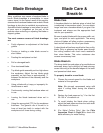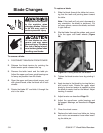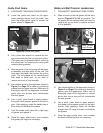
-36-
G0640X 17" Wood/Metal Bandsaw
SECTION 6: METAL CUTTING
Workpiece
Inspection
Some metal workpieces are not safe to cut with a
vertical metal cutting bandsaw; instead, a differ
-
ent tool or machine should be used.
Before cutting, inspect the material for any of
the following conditions and take the neces
-
sary precautions:
• Small or Thin Workpieces: Small or thin
workpieces are dangerous to cut if held
by hand—avoid cutting these workpieces
if possible. If you must cut a small or thin
workpiece, attach it to or clamp it between
larger scrap pieces that will both support the
workpiece through the cut and keep your fin-
gers away from the blade. Some thin sheet
metals will not withstand the forces from this
bandsaw during cutting; instead, use a shear,
nibblers, or sheet metal nippers to cut these
pieces.
• Round/Unstable Workpieces: Workpieces
that cannot be properly supported or sta
-
blized without a vise should not be cut on
a vertical metal-cutting bandsaw. Examples
are chains, cables, round or oblong-shaped
workpieces, workpieces with internal or built-
in moving or rotating parts, etc.
• Material Hardness: Always factor in the hard-
ness of the metal before cutting it. Hardened
metals will take longer to cut, may require
lubrication, and may require a different type
of blade in order to efficiently cut them.
• Tanks, Cylinders, Containers, Valves, Etc:
Cutting into containers that are pressur
-
ized or contain gasses or liquids can cause
explosions, fires, caustic burns, or machine
damage. Avoid cutting any of these types of
containers unless you have verified that the
container is empty and it can be properly sup-
ported during a cut.
• Magnesium: Pure magnesium burns eas-
ily. Cutting magnesium with a dull blade can
create enough friction to ignite the small
magnesium chips into a fire. Avoid cutting
magnesium if possible.
• Keep the upper blade guide assembly adjust-
ed to within
1
⁄4" of the workpiece.
• Avoid overheating your blade. Keep an oil
can nearby and squirt the blade near the cut
-
ting area when it gets hot or you see a small
amount of smoke. Different metals require
different types and amounts of lubrication.
• Replace, sharpen, and clean blades as nec
-
essary. Make adjustments periodically to
keep the saw running in top condition.
• Use light and even pressure while cutting.
Light contact with the blade makes it easier
to follow lines and prevents extra friction.
• Avoid twisting the blade when cutting around
tight corners. Allow the blade to saw around
the corners.
• Misusing the saw or using incorrect tech
-
niques is unsafe and results in poor cuts.
Remember—the blade does the cutting with
the operator’s guidance.
• Never start a cut with the blade in contact
with the workpiece, and do not start a cut on
a sharp edge
.
• Pay attention to the characteristics of the
chips when cutting—they are good indicators
of proper blade speed and feed rate.
Page
38 shows the basic chip characteristics and
what they mean.
• Use the right blade for the cutting task.
Cutting Tips


















